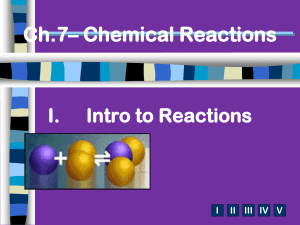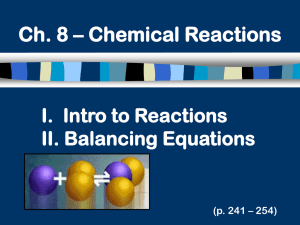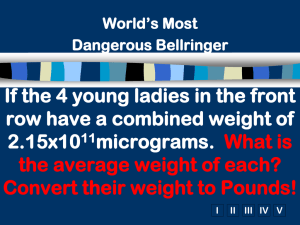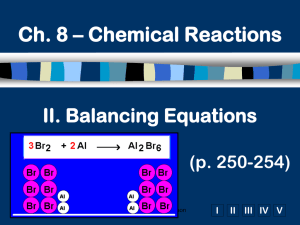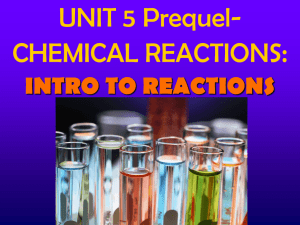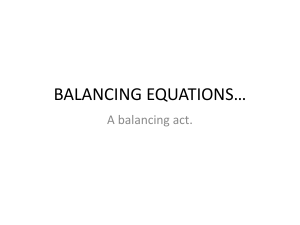Ch. 3 - Chemical Reactions
advertisement
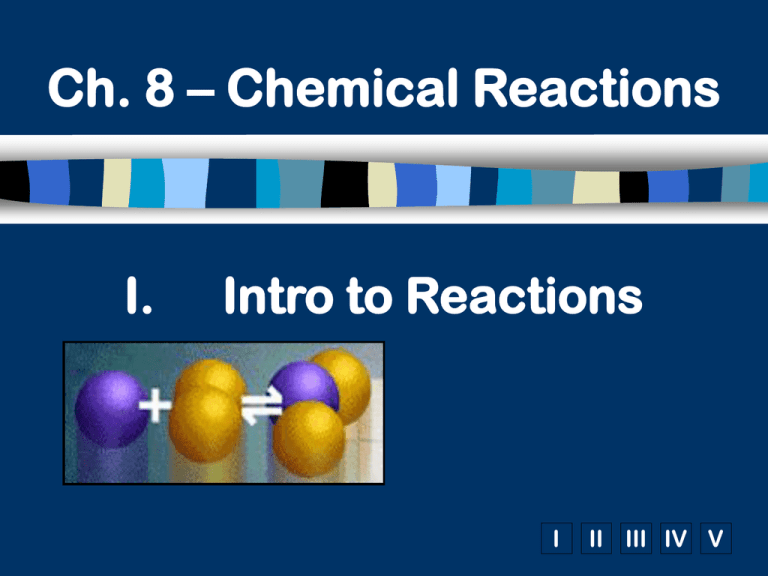
Ch. 8 – Chemical Reactions I. Intro to Reactions I II III IV V A.Signs of a Chemical Reaction Evolution of heat and light Formation of a gas Formation of a precipitate Color change B.Law of Conservation of Mass mass is neither created nor destroyed in a chemical reaction total mass stays the same atoms can only rearrange 4H 36 g 2O 4H 2O 4g 32 g C. Chemical Equations A+B C+D REACTANTS PRODUCTS C. Chemical Equations p. 246 D. Writing Equations 2H2(g) + O2(g) 2H2O(g) Identify the substances involved. Use symbols to show: How many? - coefficient Of what? - chemical formula In what state? - physical state Remember the diatomic elements. D. Writing Equations Two atoms of aluminum react with three units of aqueous copper(II) chloride to produce three atoms of copper and two units of aqueous aluminum chloride. • How many? • Of what? • In what state? 2Al(s) + 3CuCl2(aq) 3Cu(s) + 2AlCl3(aq) E. Describing Equations Describing Coefficients: individual atom = “atom” covalent substance = “molecule” ionic substance = “unit” 3CO2 3 molecules of carbon dioxide 2Mg 2 atoms of magnesium 4MgO 4 units of magnesium oxide E. Describing Equations Zn(s) + 2HCl(aq) ZnCl2(aq) + H2(g) • How many? • Of what? • In what state? One atom of solid zinc reacts with two molecules of aqueous hydrochloric acid to produce one unit of aqueous zinc chloride and one molecule of hydrogen gas. Ch. 8 – Chemical Reactions II. Balancing Equations (p. 250-254) I II III IV V A. Balancing Steps 1. Write the unbalanced equation. 2. Count atoms on each side. 3. Add coefficients to make #s equal. Coefficient subscript = # of atoms 4. Reduce coefficients to lowest possible ratio, if necessary. 5. Double check atom balance!!! B. Helpful Tips Balance one element at a time. Update ALL atom counts after adding a coefficient. If an element appears more than once per side, balance it last. Balance polyatomic ions as single units. “1 SO4” instead of “1 S” and “4 O” C. Balancing Example Aluminum and copper(II) chloride react to form copper and aluminum chloride. 2 Al + 3 CuCl2 3 Cu + 2 AlCl3 2 1 Al 1 2 3 1 Cu 1 3 6 2 Cl 3 6

